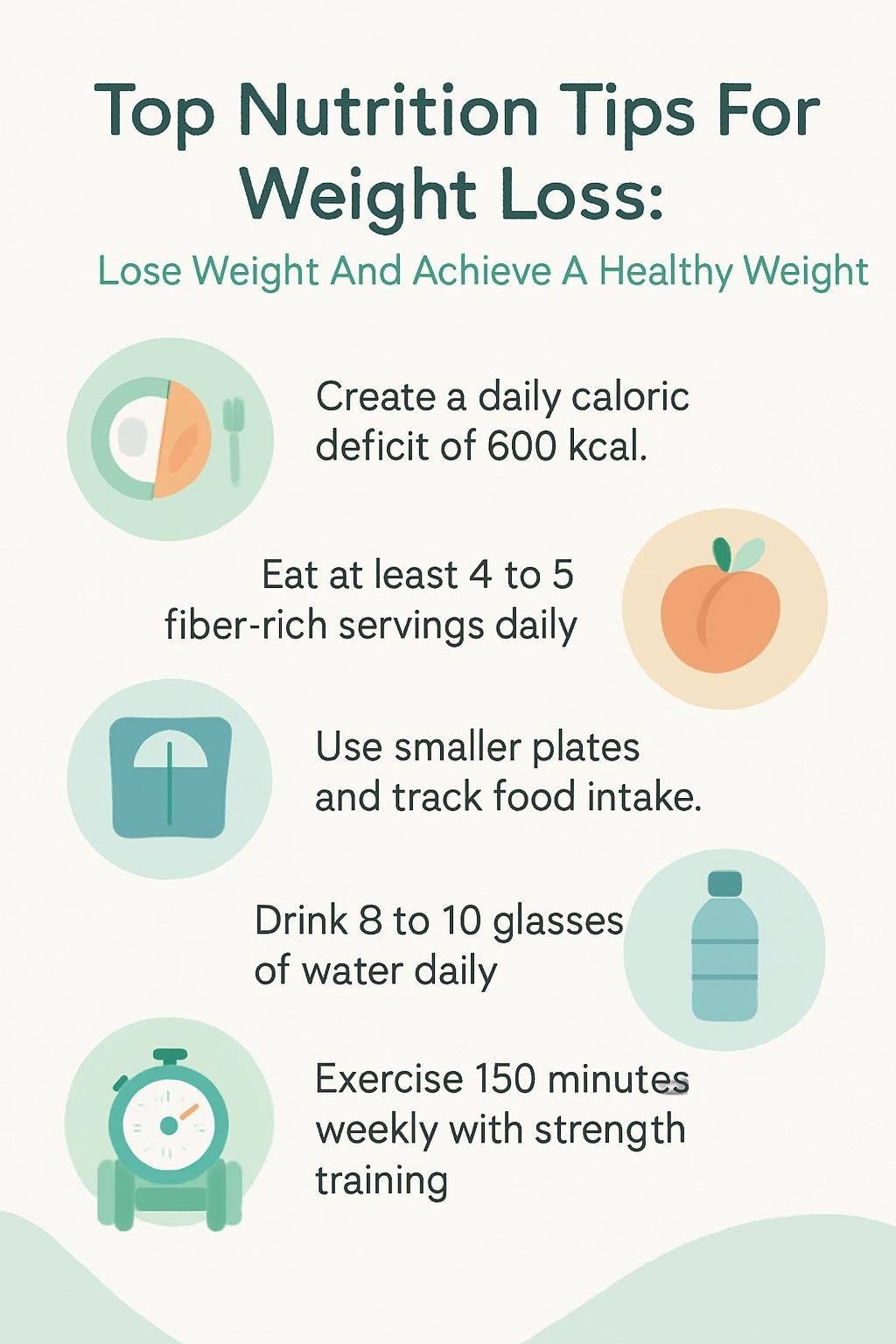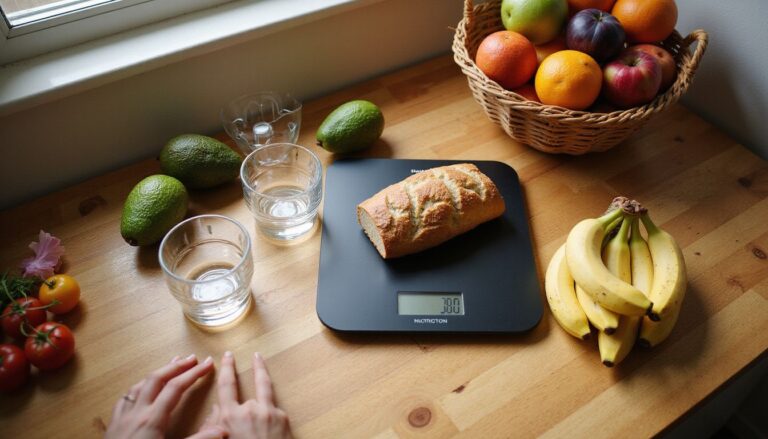Top Nutrition Tips For Weight Loss: Lose Weight And Achieve A Healthy Weight
Our Nutrition Assistant AI Suite will transform your body. You will lose fat, get toned, and build muscle. Gain confidence and optimal health.
If you want to lose weight and reach a healthy weight, the first step is knowing what to eat. Research shows that more fiber from vegetables, fruit, beans, and whole grains supports long-term weight loss and weight maintenance. This guide gives clear nutrition tips for weight loss, so you can make smart choices about food and drink, one meal at a time.
This information is educational and does not replace medical advice. If you have a health condition or take medication, speak with a healthcare professional.
Key Takeaways
- Create a daily calorie deficit of about 600 kcal. Many guides suggest about 1,900 kcal for men and 1,400 kcal for women to support steady progress.
- Eat 4 to 5 servings of fiber-rich produce and whole grains each day. Higher fiber intake is linked with lower disease risk and better appetite control (Aune et al., BMJ, 2016).
- Use smaller plates to reduce portion size. Track food intake with a calorie app or diary to keep your goals measurable.
- Drink 8 to 10 glasses of water daily. Poor hydration is linked to higher BMI and greater obesity risk in large studies.
- Move at least 150 minutes per week and add strength training twice weekly to protect muscle and support fat loss.

Fundamentals of Weight Loss

Healthy weight loss starts with energy balance. Your body uses calories for basic functions and movement. If you eat slightly fewer calories than you use, you tap into stored fat for energy. Small, steady changes beat quick fixes.
What Is a Caloric Deficit and Why Is It Important?
A caloric deficit means you eat fewer calories than your body burns. A daily reduction of about 600 kcal usually supports safe weight loss. Many adults do well around 1,900 kcal for men and 1,400 kcal for women, depending on size, age, and activity.
Tracking helps. Use a food diary or an app to log meals and drinks. Portion control matters, since even healthy foods can add up. Smaller plates, measuring cups, or a food scale make it easier to avoid overeating.
Physical activity increases your daily burn and makes the deficit easier to reach. Think of it as a small gap you create each day between what you eat and what your body needs.
How Does Metabolism Affect Weight Loss?
Metabolism is how your body turns food into energy. People with more muscle generally burn more calories at rest. Strength training supports muscle, so your body uses more energy even when you sit.
Protein-rich meals can raise your metabolic rate for a short time and help with appetite control. Hydration also supports a healthy metabolism. Poor sleep can slow metabolism and increase cravings for sugary, high-fat snacks.
After I added two short strength sessions each week and kept a water bottle nearby, progress felt easier than when I only cut desserts.
Setting Realistic Weight Loss Goals
Clear goals help you move at a safe, steady pace. Small wins build confidence and create momentum that lasts.
How Can I Set Small, Measurable Weight Loss Objectives?
- Choose a safe rate, about 1 to 2 pounds per week, as many dietitians recommend.
- Use a food diary or app to log everything you eat and drink each day.
- Make simple swaps, like eggs with vegetables for breakfast, or a salad starter at dinner.
- Set activity targets, such as a 30-minute daily walk or a step count goal.
- Plan meals and snacks with a grocery list to cut impulse buys.
- Aim for 6 to 8 cups of fluid per day, and more if you are active or live in a hot climate.
- Break goals into milestones and review progress weekly.
- I switched to smaller plates at every meal. It reduced my portions without feeling like a diet.
- Share goals with someone you trust for accountability and support.
- Celebrate small wins, like a full week of meal prep or hitting your step goal.
What Strategies Help with Long-Term Weight Loss Success?
Build meals around whole foods. Vegetables, fruit, lean protein, and whole grains keep you fuller on fewer calories. Limit highly processed foods to reduce hunger swings and prevent regain.
Stay active in ways you enjoy. Social support from friends or groups helps you follow through, especially during busy weeks. Include small treats in moderation so you do not feel restricted.
“Weight loss is not a sprint, it’s a marathon—consistency wins the race.”
Manage stress and practice self-care to reduce emotional eating. People do best when new habits fit their routine, schedule, and culture.
Choosing Nutrient-Dense Foods for Weight Loss
Nutrient-dense foods deliver vitamins, minerals, and fiber with fewer calories. Filling your plate with these foods supports a best diet strategy for weight management.
Why Prioritize Fruits, Vegetables, and Whole Grains?
Produce and whole grains add fiber, which helps you feel full longer. Many plans suggest 4 to 5 servings of fruits and vegetables each day. Try to cover at least half your plate with vegetables at most meals.
Whole grains like oats, brown rice, barley, and quinoa provide steady energy. They release glucose slowly, which helps curb cravings. I swapped white bread for whole grain toast, and late-morning hunger faded.
People who eat at least five servings of fruits and vegetables a day often see modest weight loss without feeling deprived.
How Do Proteins and Healthy Fats Support Weight Loss?
After you load up on vegetables and whole grains, add protein and healthy fats to stay satisfied. Eggs, fish, beans, tofu, and lean poultry support fullness and protect muscle. Many experts suggest fish twice weekly, including oily fish like salmon.
Healthy fats from nuts, olive oil, avocados, and seeds make meals more satisfying. Balanced meals reduce cravings for high-calorie snacks with little nutrition. Low-fat dairy, such as milk or yogurt, adds protein without excess saturated fat.
I used to crash in the afternoon. A small tub of Greek yogurt with a handful of almonds kept me full much longer than crackers.
What Foods Should I Reduce to Avoid Added Sugars?
Limit sodas, energy drinks, sports drinks, flavored waters, milkshakes, and large juices. These drinks add many calories with little nutrition. Sweets and desserts, like candy, pastries, and sugary cereals, often deliver a lot of added sugar.
Read labels closely. Items like flavored yogurt or granola bars can hide more sugar than you expect. Smaller plates and measured portions help you keep dessert in check while still enjoying it on occasion.
Portion Control Strategies
Portion size can make or break a low-calorie diet. Small visual cues help you eat less food without feeling restricted.
How Can Smaller Plates Help with Portion Control?
Smaller plates and bowls make a regular meal look bigger. That optical cue helps you feel satisfied with less. Many people eat fewer calories with this simple switch, even when the food is the same.
This approach is easy to use for breakfast, lunch, and dinner. It also reduces the urge for second helpings.
How Do I Recognize Hunger and Fullness Signals?
Pause before eating and rate your hunger. True hunger feels like an empty stomach or low energy, not boredom or stress. Eat slowly, focus on taste and texture, and stop when you feel satisfied, not stuffed.
Turn off screens during meals to avoid mindless overeating. Pre-portion snacks so you do not graze without noticing. A simple notebook or app can reveal patterns, like stress snacking late at night.
Hydration and Weight Loss
Water supports metabolism and appetite control. Staying hydrated makes it easier to reach a healthy weight.
How Much Water Should I Drink Daily for Weight Loss?
Aim for 8 to 10 glasses of water a day. Tea, coffee, and broth count toward your total if they do not add many calories. Large studies link poor hydration with higher BMI and greater obesity risk.
Drinking water before meals can help you eat fewer calories. When I tracked my fluids with my meals, I felt fuller and found it easier to skip random pantry snacks.
Why Choose Water or Herbal Tea Over Sugary Drinks?
Sugary drinks raise calorie intake quickly and offer few nutrients. Regular use is linked to weight gain, diabetes, and heart disease. Choosing water or herbal tea brings hydration with zero added sugar and zero calories.
Replace one sugary drink per day with water. Keep building on that habit. Small swaps add up over weeks and months.
Regular Exercise for Weight Loss
Movement is a powerful partner to healthy eating. Think of activity as your daily push toward better health.
How Much Exercise Is Needed Weekly to Lose Weight?
Aim for at least 150 minutes per week of moderate activity. Walking, cycling, swimming, and dancing all count. Daily 30-minute walks are one of the easiest ways to lower weight and support maintenance.
Consistent cardio plus regular movement supports your calorie deficit. Tracking workouts can be as motivating as tracking meals. I began with short evening strolls after dinner, and they quickly became my favorite way to unwind.
What Are Effective Cardio and Strength Training Mixes?
Combine cardio for calorie burn with strength training to protect muscle. Cardio can be brisk walking, biking, swimming, or dance. Add two strength days each week with weights, machines, or resistance bands.
Variety prevents boredom and improves overall fitness. Alternate days, or pair a short walk with a short bodyweight session.
Sample Weekly Mix Table:
| Day | Activity |
|---|---|
| Monday | Brisk walk, 30 minutes |
| Tuesday | Resistance band workout |
| Wednesday | Dance class, 45 minutes |
| Thursday | Active recovery, light stretching |
| Friday | Swim laps, 30 minutes |
| Saturday | Bodyweight circuit |
| Sunday | Family bike ride |
Mixing cardio and strength helps change body composition so you lose more fat and keep lean muscle.
Planning and Preparing Meals
Planning lowers stress and removes guesswork. Cooking at home gives you more control over calories, salt, and added sugar.
How Can Weekly Meal Planning Prevent Unhealthy Choices?
A weekly plan guides your shopping and reduces impulse buys. Eat before shopping to avoid grabbing high-calorie items. Prepping meals improves diet quality and supports steady weight loss.
Choose nutrient-dense foods like vegetables, fruit, whole grains, legumes, lean proteins, and healthy fats. Planning also helps you manage snacks so you do not lean on fast food during busy days.
What Are Healthy Snack Ideas for Consistency?
Keep ready-to-eat options within reach. Pre-portion nuts into small containers for work or the car. Slice carrots, bell peppers, or cucumbers, and pair them with hummus.
Stock fresh fruit for a quick snack without added sugar. Pre-portioning prevents overeating and keeps your day on track.
Meal Timing for Effective Weight Loss
Meal timing shapes hunger and energy. A simple plan can help you avoid random snacking.
Why Should I Avoid Missing Meals, Especially Breakfast?
Skipping meals often leads to larger portions later. A protein-rich breakfast, like eggs, dairy, or nut butter on whole grain toast, helps control appetite and supports energy through the morning.
Regular meal timing makes it easier to stick to your plan. It prevents extreme hunger that can lead to overeating.
What Are the Benefits of Intermittent Fasting?
Intermittent fasting limits eating to set windows, which may help create a calorie deficit. Some people find it reduces late-night snacking and improves portion awareness during meals.
Results vary. If you take medication or have a medical condition, check with a healthcare professional first. I learned that focusing on meal quality and listening to hunger cues mattered more than the exact schedule.
Importance of Sleep in Weight Loss
Sleep is a quiet helper for weight control. Poor sleep raises hunger hormones and lowers self-control.
How Many Hours of Sleep Support Weight Loss?
Most adults need 7 to 9 hours each night. Less sleep is linked to more cravings, higher calorie intake, and slower progress. Quality sleep supports metabolism and steadier energy during the day.
Tracking bedtime patterns can reveal habits that stall progress. After my surgery recovery, better sleep reduced cravings and made meal planning easier.
How Does Stress Affect Sleep and Weight Loss?
High stress can disrupt sleep and raise cortisol, a stress hormone. Poor sleep then fuels cravings for sugary and fatty snacks. The cycle makes weight management harder.
Use simple stress tools like nature walks, breathing drills, or support groups. These habits protect your sleep and your goals.
Tracking Weight Loss Progress
What you measure tends to improve. Tracking shows what works and what needs adjustment.
How Do Food Diaries and Calorie Apps Help Track Progress?
Food logs help you see patterns, like weekend overeating or oversized portions. Use an app or notebook to record meals, snacks, and drinks. Honest entries make trends clear and guide smart changes.
When results stall, review your log and adjust portions or snacks. Many people keep a steady 600 kcal deficit by using their log as a feedback tool.
Why Is Celebrating Milestones Important During Weight Loss?
Marking progress keeps motivation high. Celebrate specific wins, such as a new fitness goal or cutting added sugar for a month. Choose non-food rewards, like a new book or a movie night.
Share milestones with friends or support groups. Social encouragement reinforces the habits that help you maintain a healthy weight.
Exploring Effective Diets
Different diets can work if they emphasize whole foods, balance, and consistency. Pick an approach that fits your life.
What Are the Benefits of Low-Carb and Mediterranean Diets?
Both styles focus on vegetables, fruit, lean protein, and healthy fats. The Mediterranean pattern highlights olive oil, nuts, seeds, and seafood. Low-carb plans cut refined grains and added sugar.
Studies link these approaches with better heart health and sustainable weight loss. Many people find them satisfying because fiber and protein curb hunger.
After moving to a Mediterranean pattern, my cravings dropped and energy improved.
How Do High-Protein and Plant-Based Diets Compare?
High-protein diets feature eggs, lean meats, beans, tofu, and Greek yogurt. Extra protein at breakfast can reduce hunger later in the day, which helps manage calories. Protein also supports muscle during weight loss.
Plant-based diets center on beans, lentils, vegetables, fruit, nuts, seeds, and whole grains. Evidence links these diets to lower risk of heart disease and type 2 diabetes. Either approach can work if meals are balanced and meet your nutrient needs.
Steering Clear of Quick Fixes
Fast results are tempting, but quick fixes rarely last. Balanced habits protect your health and your progress.
Why Is Sustainable, Balanced Eating Better Than Quick Fixes?
Balanced eating covers all major nutrients, supports energy, and prevents rebound weight gain. Plans that focus on produce, whole grains, and lean proteins are easier to keep over time.
Extreme diets often lead to binge eating or burnout. Steady changes are kinder to your body and your mind.
What Are the Risks of Severe Calorie Restrictions?
Very low calorie plans can slow metabolism, reduce muscle, and trigger nutrient gaps. These effects can raise long-term health risks and promote yo-yo dieting.
Most adults do better with a moderate 600 kcal reduction. Talk with a registered dietitian or clinician before making large cuts to your intake.
Support and Accountability in Weight Loss
Few goals are achieved alone. Support and accountability make healthy habits stick.
How Can Support Groups or Nutritionists Help Weight Loss?
Group programs offer motivation, practical tips, and weekly check-ins. Many people lose more weight and keep it off longer with this kind of structure.
Registered dietitians can tailor meal plans to your medical needs and preferences. Their guidance also protects you from unsafe or unbalanced diets.
Why Should I Share My Weight Loss Goals with Others?
Sharing your goals makes them real. Encouragement from friends or family helps you bounce back after hard days and celebrate milestones.
Join a challenge, pair up with a buddy, or post weekly wins. Small layers of support add up to big progress.
Benefits of Mindful Eating
Mindful eating helps you enjoy food and stop at satisfied. A calm meal can be a powerful tool.
How Does Taking Time to Enjoy Meals Aid Weight Loss?
Eating slowly gives your brain time to register fullness, which often takes about 20 minutes. Savor flavors and textures. This simple shift can reduce overeating without strict rules.
Cooking at home and planning meals also improve portion control. More vegetables on your plate means fewer calories for the same volume of food.
Why Avoid Eating While Distracted?
Multitasking during meals leads to mindless eating. People often take in more calories when they eat in front of a screen.
Focus on your plate and pause halfway. Ask yourself if you feel satisfied. That quick check can save hundreds of calories each week.
Consideration for Supplements
Supplements are common, but they are not a shortcut. Food, movement, sleep, and support do most of the heavy lifting.
When Should I Consult Professionals About Supplements?
Speak with a healthcare professional before taking weight loss supplements. Some products can interact with medicines or worsen health issues. A clinician can help you choose what is safe and what is not necessary.
I once asked my doctor about a trendy pill. It would have clashed with my allergy medication. That visit saved me trouble.
Why Focus on Diet and Exercise Before Supplements?
Balanced meals and regular activity create the foundation for fat loss. Many adults progress on about 1,900 kcal for men and 1,400 kcal for women, with adjustments for body size and activity level.
Hit at least 150 minutes of moderate exercise per week. Drink 8 to 10 glasses of water daily. These basics support appetite control and metabolism without the risks that come with some supplements.
Maintaining a Positive Attitude Toward Weight Loss
Mindset shapes outcomes. Progress builds when you give yourself credit for each step forward.
How Can I Focus on Progress Instead of Perfection?
Track small wins. Swap soda for water, add a serving of vegetables, or take a short walk after dinner. Set simple weekly goals you can measure and repeat.
Lean on family and friends for support. Focusing on what you did right, even on tough days, keeps your momentum strong.
What Are Ways to Build Resilience Against Setbacks?
Link your goals to personal reasons, like having more energy for family or improving blood pressure. Use your support network and plan for busy weeks with quick, healthy meals.
Treat setbacks as data, not failure. Adjust your plan, then move forward with the next right step.
Conclusion
Reaching a healthy weight comes from small, consistent habits. Fill your plate with fiber-rich foods, lean proteins, and healthy fats. Limit added sugar. Manage portions, stay hydrated, and practice mindful eating at the table.
Pair regular movement with simple meal planning. Keep goals realistic, track your progress, and celebrate each step. These evidence-based weight loss tips can help you lose weight, keep it off, and feel better for the long term.
References: Aune D et al., BMJ, 2016; U.S. Dietary Guidelines; CDC and NHS public guidance on healthy weight, physical activity, and calorie balance.
FAQs
1. What are the most effective nutrition tips for weight loss and achieving a healthy weight?
Eating more vegetables, choosing whole grains, and limiting added sugars support steady weight loss. Research from the Centers for Disease Control and Prevention shows that people who eat more fiber-rich foods tend to lose more body fat over time. Tracking your food intake can also help you stay aware of portion sizes.
2. How does protein intake affect losing weight?
Protein helps control hunger by making you feel full longer after meals. Studies published in The American Journal of Clinical Nutrition found that higher protein diets led to greater fat loss compared to lower protein diets with similar calories.
3. Can drinking water help with losing excess pounds?
Drinking water before meals may reduce calorie intake since it fills your stomach temporarily. A study in Obesity showed adults who drank two cups of water before eating lost about 4 pounds more than those who did not over twelve weeks.
4. Why is tracking what I eat important for reaching a healthy body size?
Keeping a daily record increases awareness of eating habits and highlights areas needing change such as frequent snacking or large portions at dinner. In my own experience, writing down everything I ate helped me notice patterns like late-night snacks which slowed my progress toward a healthier size.
Summary: Eating high-fiber foods, increasing protein, drinking enough water, and tracking meals all play key roles in successful long-term weight management according to scientific evidence and personal application alike.







